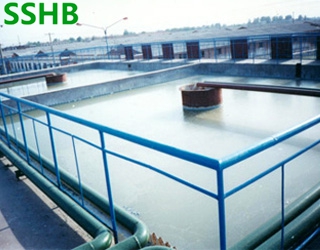大氣治理
污水處理
自動化工程

 唐山盛世環保設備有限公司
唐山盛世環保設備有限公司
公司電話:13315560268
公司傳真:0315-7122266
公司郵箱:sshbhjL@sina.com
公司地址:河北省.唐山.灤州市新城平青大路東

醫院污水經化糞池腐化處理后進入污水處理站格柵井。經格柵清除懸浮物、藥棉、紗布及糞便雜物后進入污水調節池。
Hospital sewage enters the sewage treatment station screen well after being fermented in the septic tank. After the screen removes suspended matter, medicinal cotton, gau and fecal debris, it enters the sewage regulating tank.
調節池為鋼砼結構,池內設預曝氣裝置。為防止污泥沉積,增加污水中的溶氧,采用微孔曝氣方式。曝氣后污水用無堵塞潛污泵提升進入豎流式一沉池。
The regulating tank is of steel-concrete structure, and a pre-aeration device is set inside the tank. In order to prevent sludge deposition and the dissolved oxygen in the sewage, the micro-hole aeration method is adopted. After aeration, the sewage is lifted into the vertical flow sedimentation tank by a-blocking submersible sewage pump.
豎流式一沉池底部污泥(含水率95%)用氣提送入污泥消化池進行好氧消化處理,其上清液重力流入生物接觸氧化池進行生化處理。
The bottom sludge of the vertical flow sedimentation tank (with a water content of 95%) is lifted by air into the sludge digestion for aerobic digestion treatment, and its supernatant flows into the biological contact oxidation tank for biochemical treatment by gravity.
生物接觸氧化池采用推流式。池內設半軟性填料,易結膜,不堵塞,不結球。用風機鼓風供氧 。
The biocontact oxidation tank adopts the push-flow type. The tank is equipped with semi-soft packing, which is easy to film, does not block and does not form balls. The blower is used to supply oxygen by blowing air.
接觸氧化技術是利用微生物群體附著在纖維填料的表面形成生物膜,在好氧條件下,廢水流經濾料表面,廢水中的有機物通過微生物的吸附、氧化、還原、合成過程,把廢水中的有機物氧化成無機物二氧化碳和水。主要設備為維系好氧生物細菌的半軟性填料及布氣充氧系統。
Contact oxidation technology uses microbial populations attached to the surface of fiber packing to form a biofilm. Under aerobic conditions, wastewater flows through the surface of filter material. The organic matter in the wastewater is oxidized into inorganic carbon dioxide and water through the adsorption, oxidation, reduction, and synthesis processes of micro. The main equipment includes semi-soft packing for maintaining aerobic bacteria and a gas distribution and aeration system.
二沉池采用豎流斜管式。二沉池底部污泥用氣提法送入污泥消化池進行好氧消化處理,其上清液進入消毒池。
The secondary sedimentation tank is of the vertical flow type with inclined tubes. The sludge at the bottom of the secondary sedimentation tank is lifted by into the sludge digestion tank for aerobic digestion treatment, and its supernatant enters the disinfection tank.
消毒池加入固體氯片(或次氯酸鈉溶液)進行消毒滅菌處理。
Solid chlorine tablets (or sodium hypochlorite solution) are added to the disinfection tank for disinfection and sterilization treatment.
一沉池和二沉池的污泥均采用污泥消化池進行好氧消化處理。好氧消化處理的原理是將污泥通過混合、曝氣,達到自身氧化期,即內源呼吸期。經過內源呼吸期,使污泥中僅存在無機非分解物質,使污泥趨向穩定狀態。好氧消化目的是減少污泥量。大部分污泥經過好氧消化轉換成揮發性物質CO2、NH3、H2等。
The sludge of primary and secondary sedimentation tanks is treated by aerobic digestion in the sludge digestion tank. The principle of aerobic digestion treatment is mix and aerate the sludge to reach the self-oxidation period, that is, the endogenous respiration period. After the endogenous respiration period the sludge only contains inorganic non-degradable substances, making the sludge tend to a stable state. The purpose of aerobic digestion is to reduce the amount ofudge. Most of the sludge is converted into volatile substances such as CO2, NH3, and H2 through aerobic digestion.
污泥經好氧消化,加藥消毒滅菌處理后,外運處置,污水經消毒處理后達標排放。
Sludge is digested aerobically, disinfected and sterilized by adding medicine, and then transported out for disposal. The sewage is discharged to the standard after disinfection treatment.